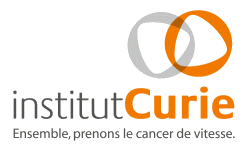
The web supplement to
Maya Ridinger-Saison et al. 2011



|
|


|
| Spi-1/PU.1 activates transcription through clustered DNA occupancy in erythroleukemia |
| Maya Ridinger-Saison1,2,10, Valentina Boeva1,3,7,10, Pauline Rimmelé1,2,4, Ivan Kulakovskiy5,6, Benjamin Levavasseur1,2, Isabelle Gallais1,2, Caroline Paccart1,3,7, Patricia Legoix-Né9, Philippe Hupé1,3,7,8, Alain Nicolas9, Emmanuel Barillot1,3,7, Françoise Moreau-Gachelin1,2 and Christel Guillouf1,2,11 |
|
1Institut Curie, Paris, F-75248 France.2Inserm U830, Paris, F-75248 France. 3Inserm U900, Paris, F-75248 France. 4Present address: Mount Sinai School of Medicine, NY, USA. 5Laboratory of Bioinformatics and Systems Biology, Engelhardt Institute of Molecular Biology, Russian Academy of Sciences, Moscow 119991, Russia. 6Laboratory of Bioinformatics, Research Institute for Genetics and Selection of Industrial Microorganisms, Moscow 117545, Russia. 7Mines ParisTech, Fontainebleau, F-77300 France. 8CNRS UMR144, Paris, F-75248 France. 9NGS Platform-Institut Curie, Paris, F-75248 France. 10These authors contributed equally to this work. |
|
Abstract Acute leukemias are characterized by genetic alterations that modulate the activity of transcription factors and deregulate the transcriptional networks controlling hematopoietic lineage specificity. Aberrant expression of Spi-1/PU.1, which is an ETS transcription factor required for myelopoiesis and B-lymphopoiesis, causes acute erythroleukemias in mice. To determine how the Spi-1 oncogene mechanistically influences the transcriptional program in erythroleukemic cells, we combined a ChIP-seq analysis of Spi-1 with Spi-1 transcriptional profiling in an erythroleukemic mouse model. We show that Spi-1 displays a selective DNA-binding activity that does not insinuate transcriptional activity. Moreover, genome-wide analysis reveals distinct properties for Spi-1 transcriptional activation and repression according to location and profile of Spi-1 DNA binding. In particular, Spi-1 binding close to TSS favors transcriptional activation, whereas binding to regions distal from TSS favors gene repression. We find no evidence of a requirement for cis-cooperating DNA binding factors in transcriptional regulation, process that is critical for Spi-1 function in myeloid and lymphoid cells. As an alternative, the function of Spi-1 as a transcriptional activator is favored by Spi-1 binding at multiple motifs associated with high Spi-1 binding intensity. The particular spacing and relative orientation of Spi-1-binding motifs within the clusters provides evidence for the biological relevance of the recruitment of Spi-1 clusters during the transcriptional activation. Moreover, our findings show that the CpG islands in promoters influence this pattern of Spi-1 binding. Altogether, our work highlights a major mechanism for gene activation arising from the aberrant expression of a transcription factor. |
| Download data: | ||
| Supplementary information (.xls) | Get it | |
| Affymetrix raw files (.CEL) | Get them (.zip) | |
| Affymetrix normalize data (.txt) | Get it | |
| Last modified November 17 2011 17:17:37 |